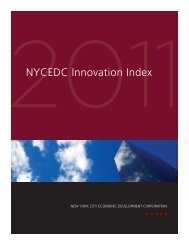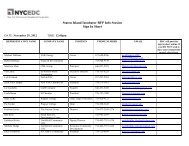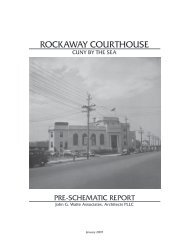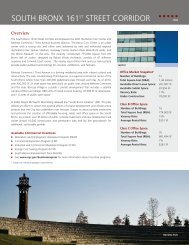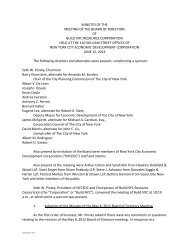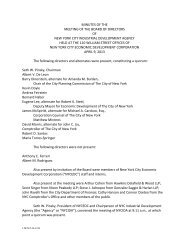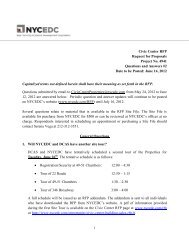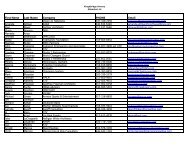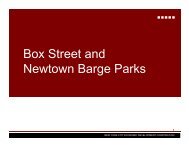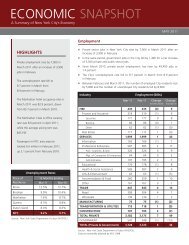No 7 Secaucus Extension Final Report - NYCEDC
No 7 Secaucus Extension Final Report - NYCEDC
No 7 Secaucus Extension Final Report - NYCEDC
You also want an ePaper? Increase the reach of your titles
YUMPU automatically turns print PDFs into web optimized ePapers that Google loves.
<strong>No</strong>. 7 <strong>Secaucus</strong> <strong>Extension</strong>Feasibility Analysis <strong>Final</strong> <strong>Report</strong>The Working Group evaluated several options for advancing the <strong>No</strong>. 7 <strong>Secaucus</strong> <strong>Extension</strong>project through FTA’s funding and environmental processes. The goal of the Working Group wasto build upon the review and approval process for the ARC project, including the extensiveanalysis, documentation, and citizen participation components that have occurred since theARC project development process began in 1995, to determine how the prior data collectionand analyses could be used to advance the <strong>No</strong>. 7 <strong>Secaucus</strong> <strong>Extension</strong> with FTA.The Working Group’s report evaluated the alternatives that were previously assessed during thedevelopment of the LPA for the ARC project, including several options for extending the NewYork City subway to New Jersey, and found that the <strong>No</strong>. 7 <strong>Secaucus</strong> <strong>Extension</strong> generallyaddressed the Purpose and Need/Goals and Objectives established in the ARC AlternativesAnalysis (AA) and the associated National Environmental Policy Act (NEPA) environmentalreview. Additional environmental studies would be necessary to address impacts that would bedifferent from those generated by the ARC LPA.The final decision on the required approach rests with FTA, and the Working Group suggests thatconsultation with FTA concerning the AA process should be one of the early next steps if the<strong>No</strong>. 7 <strong>Secaucus</strong> <strong>Extension</strong> concept is pursued further. The Working Group recommendsproposing to FTA that preparation of a new AA is not needed and that the <strong>No</strong>. 7 <strong>Secaucus</strong><strong>Extension</strong> be selected as the revised LPA after the issuance of a revised LPA report, publicmeetings, and an update of the Regional Transportation Plans of the New York and New JerseyMetropolitan Planning Organizations. If the <strong>No</strong>. 7 <strong>Secaucus</strong> <strong>Extension</strong> is selected as the revisedLPA, the appropriate NEPA process will need to be completed. The Working Group recommendsthis approach, but recognizes that the FTA in its discretion could require the lead agency to startproject review and development from the beginning. The lead agency or agencies would haveto be decided upon before approaching FTA.While it is hard to predict exactly how long the Working Group’s recommended process wouldtake if FTA accepts it, the Working Group estimates that it would take approximately three yearsto amend the ARC LPA, complete the appropriate NEPA process, and reach a Record ofDecision (ROD). The Working Group also recommended that early consultation with Amtrak tocoordinate approaches to project planning and environmental review for the <strong>No</strong>. 7 <strong>Secaucus</strong><strong>Extension</strong> and Amtrak’s Gateway project.Legal Issues Working GroupThe Legal Issues Working Group identified and evaluated key legal considerations raised by the<strong>No</strong>. 7 <strong>Secaucus</strong> <strong>Extension</strong>, and the full report is included as Appendix B. Some of the issuesidentified could be resolved once the alignment and development plans are finalized. Certainmembers of the working group have identified some issues as gating issues, which must beanswered definitively before any work can proceed. The final report is divided into five areas:1) Real Estate Property Acquisition – The report identifies real estate parcels currently expectedto be affected by the <strong>No</strong>. 7 <strong>Secaucus</strong> <strong>Extension</strong> and the property interests that would beneeded. The acquisition of parcels related to parkland raises special considerations andwould require consultation with various entities in each State. An inter-agency agreementbetween MTA-NYCT (NYCT) and NJ TRANSIT would also be necessary to account for NYCT’santicipated operation of the <strong>No</strong>. 7 over property owned by NJ TRANSIT.VII




